
Banksia nobilis, commonly known as the golden dryandra, great dryandra or kerosene bush, is a shrub of the family Proteaceae which is endemic to Western Australia. It occurs on lateritic rises from Eneabba to Katanning in the state's Southwest Botanic Province. With large pinnatifid leaves with triangular lobes, and a golden or reddish pink inflorescence, it is a popular garden plant. It was known as Dryandra nobilis until 2007, when all Dryandra species were transferred to Banksia by Austin Mast and Kevin Thiele. There are two subspecies, B. nobilis subsp. nobilis and B. nobilis subsp. fragrans.

Banksia proteoides, commonly known as king dryandra, is a shrub endemic to Western Australia. It was known as Dryandra proteoides until 2007, when all Dryandra species were transferred to Banksia by Austin Mast and Kevin Thiele.

Grevillea flexuosa, commonly known as zigzag grevillea or tangled grevillea, is a species of flowering plant in the family Proteaceae and is endemic to the south-west of Western Australia. It is an erect shrub with divided leaves, these lobes with three to five triangular lobes, and cylindrical clusters of cream-coloured to pale yellow flowers.
Conospermum acerosum, commonly known as needle-leaved smokebush, is a shrub endemic to Western Australia
Conospermum glumaceum, commonly known as hooded smokebush, is a shrub endemic to Western Australia.

Conospermum stoechadis, commonly known as common smokebush, is a shrub endemic to Western Australia.
Conospermum stoechadis subsp. sclerophyllum is a shrub endemic to Western Australia.
Conospermum incurvum, commonly known as plume smokebush, is a shrub endemic to Western Australia.

Stirlingia simplex is a plant endemic to Western Australia.

Stirlingia latifolia, commonly known as blueboy, is a plant endemic to Western Australia.

Isopogon sphaerocephalus, commonly known as drumstick isopogon or Lesueur isopogon, is a species of plant in the family Proteaceae and is endemic to the south-west of Western Australia. It is a shrub with linear to narrow egg-shaped leaves and spherical heads of hairy white to creamy yellow flowers.

Kunzea pulchella, commonly known as granite kunzea, is a flowering plant in the myrtle family, Myrtaceae and is endemic to the south-west of Western Australia. It is a shrub with spreading branches, egg-shaped to lance-shaped leaves and loose groups of red flowers, each on a short stalk so that the branch is visible between the flowers.

Pithocarpa is a genus of Australian plants in the pussy's-toes tribe within the daisy family.

Adenanthos barbiger, the hairy jugflower or hairy glandflower, is a species of shrub in the family Proteaceae. It is endemic to the south-west of Western Australia. It usually grows to 1 metre high, and has bright red flowers that appear mostly between August and December. The species was first formally described in 1839 by English botanist John Lindley in A sketch of the vegetation of the Swan River colony.

Scaevola platyphylla, commonly known as broad-leaved fanflower, is a shrub in the family Goodeniaceae. It is endemic to the south-west of Western Australia. Plants grow to between 0.3 and 1.3 metres high and have blue to purple flowers that appear between August and January in their native range.

Dampiera alata is a plant in the family Goodeniaceae, native to Western Australia.

Gastrolobium villosum is a low spreading shrub in the pea family (Fabaceae), native to Western Australia. Like most Gastrolobiums it is poisonous to stock.

Asteridea pulverulenta is a species of flowering plant in the Asteraceae family, which is endemic to Western Australia, in the south-west. It was first described in 1839 by John Lindley.

Asteridea chaetopoda is a species of herb in the Asteraceae family, which is endemic to Western Australia, in the south-west. It was first described in 1876 as Athrixia chaetopoda by Ferdinand von Mueller, and allocated to the genus, Asteridea, in 1980 by G. Kroner. It is a perennial herb, growing on sandy soils, on limestone and on gypsum, to heights from 5 cm to 30 cm. Its yellow flowers may seen from August to November on salt lakes, stony rises, and dunes of Beard's Eremaean and South-West Provinces.

Conostephium minus, common name pink-tipped pearl flower, is a shrub in the Ericaceae family, endemic to Western Australia.
















